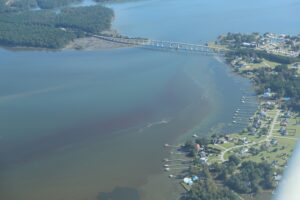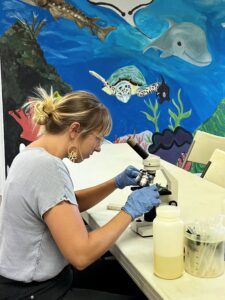Algae Bloom Response 
Coastal Carolina Riverwatch provides algae bloom identification and outreach response services to coastal NC.
Please report fish kills and algae blooms to Waterkeeper@coastalcarolinariverwatch.org
 Reporting – Identification – Outreach
Reporting – Identification – Outreach
Coastal Carolina Riverwatch Algae Bloom Response Team (ABRT) includes the White Oak Waterkeeper and citizen scientists and researchers just like you. Many times algae blooms are reported by concerns citizens who are on the water frequently and notice changes in what they see and smell.
Once reported, the Waterkeeper will collect samples and identify any algae present in the sample. If there is a presence of a harmful algae, the Waterkeeper will work with the ABRT to continue monitoring, notify fishermen and residents in the area, and create and publish outreach content about how to stay safe and how to prevent harmful algae blooms.
Ways to volunteer:
Aerial monitoring with drones from your local waterway.
Reporting strange odors or colors in the water.
Creating content to notify the community about harmful algae blooms (HABs), when identified and let folks know how they can prevent HABs.
Want to get involved in helping your community through citizen science and advocacy, contact us at Waterkeeper@coastalcarolinariverwatch.org and be a part of our team.
Current Information on HABs in the White Oak River Basin (Onslow/Carteret)
New River Harmful Algae Bloom in 2022 – Click here for information.
*Green circles indicate recent HAB events in the White Oak River Basin.
